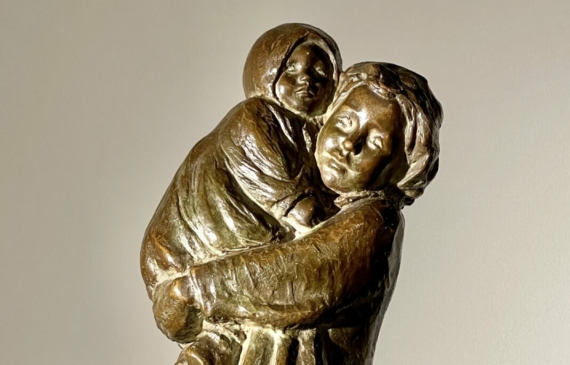
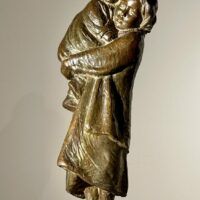

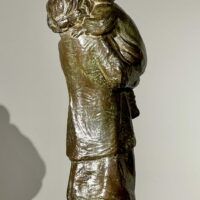

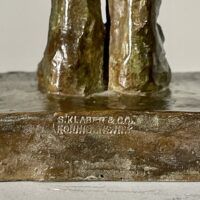
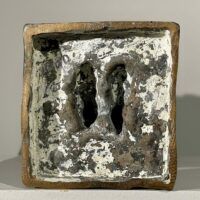
Abastenia St. Leger Eberle (American, 1878-1942)
Little Mother, 1907
Bronze, 12 7/8 H. x 4 ¼ W. x 4 3/8 D. inches
Signed: ASt.L. Eberle. 1911
Stamped: S. KLABER & CO. / FOUNDERS, N.Y.
Provenance:
Private collection, New Jersey since circa 1970
Little Mother epitomizes the empathy Eberle felt toward the immigrants of the lower East Side, Washington Square and the West Village of New York, who so inspired her work at this period. What George Luks and Robert Henri immortalized in their portraits of the underclass, Eberle paralleled in her sculptures. Like these painters, the message that Eberle puts forward in her depiction of the Little Mother is a feeling of optimism that was shared by the Irish, Italian and Jewish immigrants who were carving out their futures with hard work and determination. The older sister is not down trodden and evokes an admirable respect for the responsibility a sibling might have shouldered within these family units. It is a model that demonstrates Eberle’s core interest to artistically document an unheralded part of society and culture that she experienced on a day to day basis outside her studio.
Abastenia St. Leger Eberle was born in Webster City, Iowa, on April 6th, 1878. She spent her youth in Canton, Ohio, and Puerto Rico. During her youth she began to sculpt in clay the native life and scenes she observed. In 1899 Eberle started studying at the Art Students’ League in New York City with Kenyon Cox, C.Y. Harvey, and George Grey Barnard.
In 1904 and 1905 she collaborated with Anna Hyatt Huntington on a few group sculptures. Eberle sculpted the human figures and Anna Huntington modeled the animals. In the early 1900s Eberle also spent time in Italy and Paris where she had some of her work cast.
Eberle focused her sculptures on simple human themes with careful attention to the mass and movement of the piece. She was inspired by the writings of Jane Addams to create sculptures with social as well as artistic significance. In the summer of 1907, Eberle stayed at the Music School Settlement. Although music classes were suspended for the summer, the settlement remained open as a recreational center for the surrounding neighborhood. Here she began observing the people of the area to learn more about the conditions under which they lived as well as to help them when she could. After some time, the people started to trust her and she began using the neighborhood children as models. The summer Eberle spent at the Music School Settlement helped her realize that urban life was what she enjoyed portraying in her work. This then led Eberle to frequent the lower East Side of New York City, as a result a number of her sculpture subjects came from viewing the people who lived there, especially the children. She found that the children of the Lower East Side played without restraint and expressed their emotions without any inhibition. She said “The children of the East Side play without restraint; their griefs and their joys are expressed with absolute abandon… and their natural emotions are not restrained by the pretty curtsies taught by governesses…. They laugh loudly, they shout. They race on roller skates and dance unrestrainedly…. They express life.” The Little Mother was conceived in 1907, the year in which Eberle moved her studio to West 9th Street. This location is near Washington Square where the inhabitants were largely of Irish and Italian descent. It was near Washington Square where Eberle found the Italian models for her work, Little Mother. In 1907, Eberle began an association with the Macbeth Gallery in New York and 1909 the Metropolitan Museum of Art purchased Roller Skater. This made Eberle the youngest sculptor represented in the museum at the time. In 1910, Eberle was exhibited at the winter exhibition of the National Academy of Design and won the Helen Foster Barnett prize for the best sculpture by an artist under 35 years old.
The casting of Eberle’s sculptures may not have been limited as other artists had done. If there was a market for a certain piece, she would have it cast. This is mostly the case for her widely popular bookends. However in the case of her genre sculptures, they were most likely cast in relatively limited numbers. As an example, her Hide and Seek bookends were produced in large quantities but the records from Macbeth Gallery show that all 83 pairs had been sold. As for her genre figures, the Roller Skater was said (by Eberle herself) to have been cast six or eight times as well as five casts of Windy Doorstep.
During her life she was a member of the National Sculpture Society and an associate of the National Academy of Design. Eberle’s work can be found in numerous public collections including: The Detroit Institute of Art, The Metropolitan Museum of Art, the Whitney Museum of American Art, and Brookgreen Gardens, South Carolina. She also exhibited at the Armory show in 1913 with Girls Wading and White Slave.
Exhibition History:
Collections: